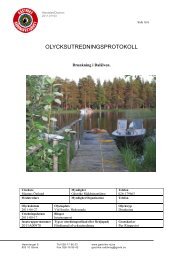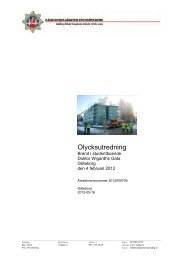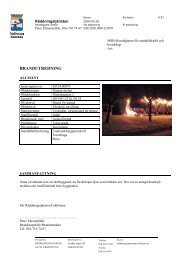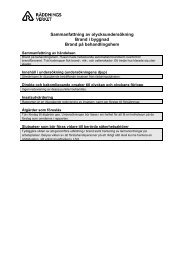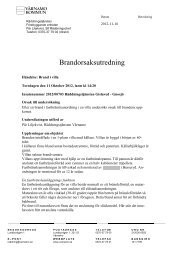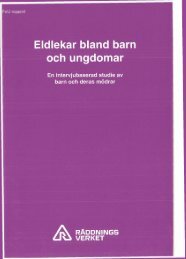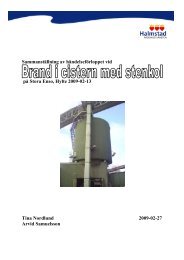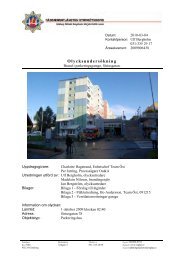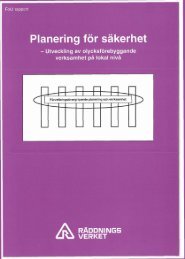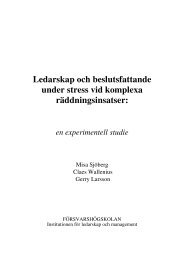30discussed above. Furthermore, it would be possible to use results from such tests forcomparison to simulations in development <strong>of</strong> mathematical models.A survey <strong>of</strong> the potential risk for spontaneous ignition in various wood stock storages inSweden is presented here. It is found that the largest risk for spontaneous ignition wouldbe in storages <strong>of</strong> moist bi<strong>of</strong>uel. Storage <strong>of</strong> fuel with high moisture content gives suitableconditions for growth <strong>of</strong> bacteria and fungus that produces heat in the low temperatureregime. Heat produced from microorganisms is normally a prerequisite for attaining thetemperature regime where oxidative processes commence. The types <strong>of</strong> bi<strong>of</strong>uels thatwould induce the highest risk for spontaneous ignition in storage, and that can be found inlarge quantities in storage, would be wood chips, sawdust and bark, if using moisturecontent as criteria. Dry refined wood fuels as pellets, briquettes and pulverized woodwould thus give a low risk for spontaneous ignition. There would, however, be a riskassociated even with these fuels if not stored properly, allowing the material to get moistinitiating microbial growth.
315 References1. Bowes, P.C., Self-heating: evaluating and controlling the hazards, ed. B.R.E.Departement <strong>of</strong> the Environment. 1984, London: Her Majesty's Stationary Office.471.2. Beever, P.F., Self-heating and <strong>Spontaneous</strong> Combustion, in The SFPE Handbook <strong>of</strong>Fire Protection Engineering, P.J. DiNenno, Editor. 1995, NFPA: Quincy,MA. p.2:180-189.3. Boddington, T., B.F. Gray, and D.I. Harvey. Thermal theory <strong>of</strong> spontaneousignition: Criticality in bodies <strong>of</strong> arbitrary shape. in Philosophical transactions <strong>of</strong> theRoyal Society. 1971.4. Barzykin, V.V., et al., Title. Zh. Prik. Mekh. i Tekh. Fiz., 1964. 3(118).5. Tyler, B.J. and T.A.B. Wesley. Numerical calculations <strong>of</strong> the critical conditions inthermal explosion theory with reactant consumption. in 11th Symposium onCombustion. 1667.6. Adler, J. and J.W. Enig, The Critical Conditions in Thermal Explosion Theory withreactant Consumption. Combustion and Flame, 1964. 8: p. 97-103.7. Carter, M.R., O.J. Druce, and G.C. Wake. Phase-plane analysis <strong>of</strong> criticality forthermal explosions with reactant consumption. in Proceedings <strong>of</strong> the Royal SocietyLondon. 1979.8. Takeno, T. and K. Sato, Effects <strong>of</strong> Oxygen Diffusion on <strong>Ignition</strong> and Extinction <strong>of</strong>Self-Heating Porous Bodies. Combustion and Flame, 1980. 38: p. 75-87.9. Akgun, F. and R.H. Essenhigh, Self-ignition characteristics <strong>of</strong> coal stockpiles:Theoretical prediction from a two-dimensional unsteady-state model. FUEL, 2001.80: p. 409-415.10. Krishnaswamy, S., P.K. Agarwal, and R.D. Gunn, Low-temperature oxidation <strong>of</strong>coal; 3. Modelling spontaneous combustion in coal stockpiles. FUEL, 1996. 75(3):p. 353-362.11. Back, E.L., Auto-ignition in Hygroscopic, Organic Materials - Especially ForestProducts - as Initiated by Moisture Absorption from the Ambient Atmosphere. FireSafety Journal, 1982. 4(3): p. 185-196.12. Gray, B.F., et al., Wetting-induced ignition in cellulosic materials. Fire SafetyJournal, 2002. 37: p. 465-479.13. Wolters, F.C., et al. Size constraints on self ignition <strong>of</strong> charcoal briquets. in 7thIAFSS Symposium. 2002. Worcester, USA.14. Gray, B.F., J.F. Griffiths, and S.M. Hasko, <strong>Spontaneous</strong> <strong>Ignition</strong> Hazards inStockpiles <strong>of</strong> Cellulosic Materials: Criteria for Safe Storage. Journal <strong>of</strong> ChemicalTechnology in Biotechnology, 1984. 34A: p. 453-463.15. Jones, J.C., et al., The Self-Heating and Thermal <strong>Ignition</strong> Propensity <strong>of</strong> Forest FloorLitter. Joulrnal <strong>of</strong> Fire Science, 1990. 8(May/June): p. 207-223.16. Chen, X.D. and L.V. Chong, Some Characteristics <strong>of</strong> Transient Self-Heating Insidean Exothermically Reactive Porous Solid Slab. Process Safety and EnvironmentalProtection: Transactions <strong>of</strong> the Institution <strong>of</strong> Chemical Engineers, Part B, 1995. 73:p. 101-107.17. Cuzzillo, B.R., Pyrophoria, PhD Thesis 1997, University <strong>of</strong> California at Berkeley,p. 182.18. Nugroho, Y.S., A.C. McIntosh, and B.M. Gibbs, Low-temperature oxidation <strong>of</strong>single and blended coals. FUEL, 2000. 79: p. 1951-1961.




